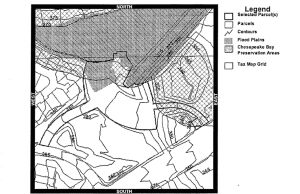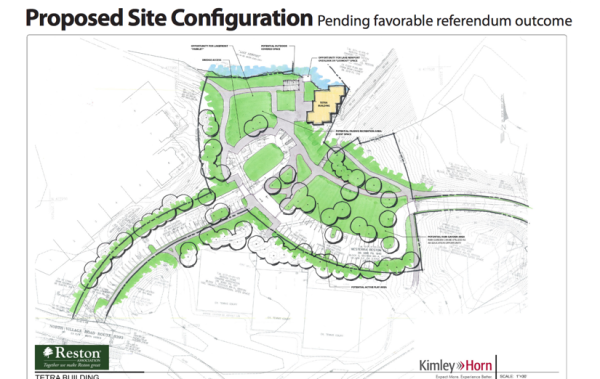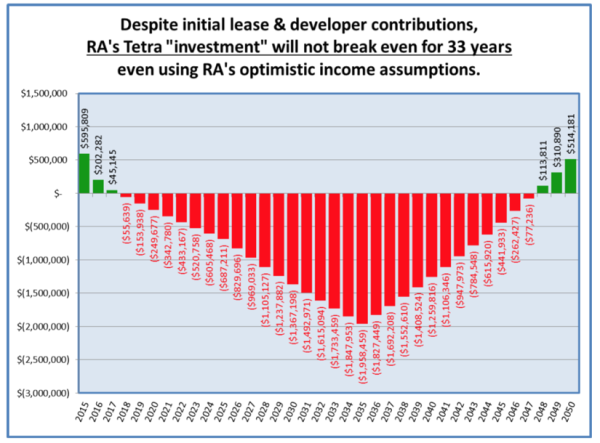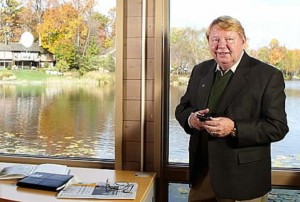 Real Estate developer William “Bill” Lauer — who played an important role in building Reston — died unexpectedly at his Reston home Tuesday.
Real Estate developer William “Bill” Lauer — who played an important role in building Reston — died unexpectedly at his Reston home Tuesday.
A native Washingtonian, Lauer founded Tetra Partners in 1978. Prior to that, he was with two homebuilding companies and for Gulf Reston in the 1960s and 70s as Reston developed as a New Town.
Lauer’s job with Gulf Reston was was to get all the new residential and commercial spaces sold and leased. He said in a recent profile for Executive Leaders Radio he was up for the challenge.
“That total immersion taught me everything from property management to country club construction,” he said. “It was a melting pot of opportunity that you can’t get anywhere. When it comes to real estate, there’s no school better than the School of Hard Knocks, and I was enrolled in advanced courses.”
During his long career, Lauer played an active role in industry trade associations and was on the executive committee of the Northern Virginia Transportation Alliance.
He was also active in many charitable organizations, including the Lions Club, Joe Gibbs Youth for Tomorrow, Ronald McDonald House, Habitat for Humanity, Alternative House, Home Aid, Cornerstones and Devotion to Children. Devotion to Children was founded by his wife, Rosemary Tran Lauer, who survives him.
Lauer was a former member of the board of Cornerstones (the called Reston Interfaith). He served on the Affordable Housing Task Force launched by Rep. Gerry Connolly that worked to provide avenues for low-income families to rent and own homes. He also served on the governing board of the county’s Partnership to Prevent and End Homelessness.
In 2008, Tetra was honored with a Best of Reston award for its community service.
Lauer said in a mission statement on Tetra’s website he was pleased that his grown children worked at Tetra with him and that he ran a business where everyone was family.
“We run as a family business, and I am blessed not only to have members of my family working with me, but also a workplace where every professional feels part of a larger family,” he said. “This environment fosters open communication where ideas are exchanged freely and allows us to get things done quickly. “
“While I am proud of the accolades, awards and success we have achieved over the years, I am most grateful for the relationships and friendships that we have forged and maintained. These relationships are the cornerstone of our success; and I can not thank our clients, advisors and families enough for their support.”
Service information is pending.
Photo: Bill Lauder/Credit: Tetra Partners
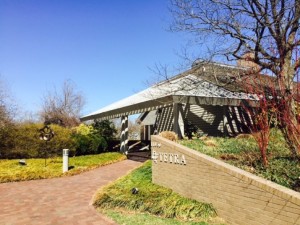 It’s getting down to the wire for the Reston Association member referendum on the purchase of the former visitors center.
It’s getting down to the wire for the Reston Association member referendum on the purchase of the former visitors center.
Haven’t voted yet? You have until Friday at 5 p.m.
RA needs a quorum of member approval to borrow and spend up to $2.65 million on the 3,123-square-foot building on the shores of Lake Newport. RA will spend additional money to repurpose the building, currently office space for Tetra Partnerships, into event and community space. It forecasts bringing in more than $100,000 annually from event rentals. It also says purchasing the building, which sits on 3.48 acres adjoining other RA community space, will preserve open space and fend off possible commercial development.
There is a vocal opposition that says the purchase price is far too high as the most recent Fairfax County tax assessment was $1.2 million. The opposition also says the site sits on a resource protection area and cannot be redeveloped commercially.
This is an op-ed by Reston resident Terry Maynard. It does not represent the opinion of Reston Now.
As the end of the Tetra referendum period approaches, I thought it useful to summarize the key reasons why RA members should not pay $2.65 million to buy this property. I hope it encourages you who have not yet voted to decide to dig around in your old RA mail (digital or postal) and submit your ballot with a “NO” vote.
1. No further development of the property will be permitted. The alleged compelling reason for buying Tetra is to prevent development there. The fact is that almost every square foot of the Tetra property is protected from further development by multiple layers of legal, regulatory, and plan restrictions.
In contrast, Reston National Golf Course is protected from development only by plan language, not a law. The difference is between what’s prevented by law at Tetra and what’s preferred in the plan at RNGC.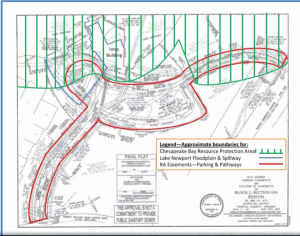
For the Tetra property, the most important of legal restriction is the state’s Chesapeake Bay Preservation Act, which calls for water bodies and the first 100′ of perennial waterfront areas (like Lake Newport) to be protected from development.
(The attached map of the Tetra property shows the area protected by this law and other restrictions.) The Virginia Department of Environmental Quality says:
“The Chesapeake Bay Preservation Act and regulations require that a vegetated buffer no less than 100 feet wide be located adjacent to and landward of all tidal shores, (etc.) … These features, including the 100-foot buffer, comprise the Resource Protection Area (RPA) … Generally, vegetation in the 100-foot buffer must be preserved on lots that include an RPA, and established where it does not exist. “
For more on RPA legalities as applied to the Tetra property, read this RestonNow op-ed from a local land use attorney who explains in detail that there is no possibility of lakeshore development there.
Second, there are legal flood plain and spillway protections on the property that, except for a patch next to the Tetra building, similarly preclude development along the lakefront and down around the dam to the stream below.
Third, an RA easement covers most of the property beyond the RPA for its parking lot, access roads, and the pathways beside them as shown on the map. Moreover, if a developer wanted to build on the Tetra property, its proposal would have to be approved by RA’s Design Review Board, including inputs from neighboring “affected parties.”
For all practical purposes, nothing can be built there without RA Board approval.
A fourth, thin added layer of protection — like that which protects the golf course — will be provided by the new Reston Master Plan when it’s approved by the Board of Supervisors this June. The new plan changes the area’s designation from a “convenience center” to remain “as built.”
Trying to peel that legal, regulatory, and political onion would almost certainly be impossible. Yet even RA ownership of the property would not guarantee the property will remain green space as the Board’s stunning decision to swap an acre of our hardwood forest (to become a parking garage) for a roadside drainage ditch illustrates.
2. The sales price and related RA financial assumptions are outrageous. The RA Board’s sales contract with Tetra calls for it to pay $2.65 million (Article 2, p. 2) for a property that RA’s appraiser says is worth $1.3 million as built, assuming it’s in good condition (p. 22). The County puts the fair market value of the property at $1.2 million in its latest real estate tax assessment. The additional $1.3-$1.5 million in the appraisal comes from assuming additional offices are there — that cannot be built!
Both the RA appraisal and the County assessment assume the property is in good condition. It is not. Read More
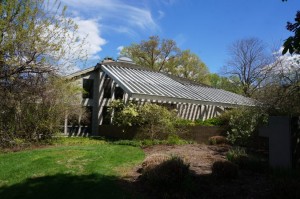 This is an op-ed by Reston Association Lake Anne/Tall Oaks Director Eve Thompson, who also is a Realtor. It does not reflect the opinion of Reston Now.
This is an op-ed by Reston Association Lake Anne/Tall Oaks Director Eve Thompson, who also is a Realtor. It does not reflect the opinion of Reston Now.
As I’ve talked with members regarding the proposed purchase of the Tetra property, one of the questions most often asked is “Why is there a difference between the assessment and the sale price?” Below is a detailed answer to that question. If you have other questions about the referendum, the property, want to see more detailed information, or want to cast your ballot, please visit the Tetra property page.
Assessed values are normally not used to establish negotiated sale prices for commercial property. It is the other way around — negotiated sale prices for commercial sale property are used to determine assessed values. This is so because the definition of fair market value is:
“The most probable price which a property should bring in a competitive and open market under all conditions requisite to a fair sale, with the buyer and seller each acting prudently and knowledgeably, and assuming the price is not affected by undue stimulus. Implicit in this definition is the consummation of a sale as of a specified date and the passing of title from seller to buyer under conditions whereby:
- Buyer and seller are typically motivated;
- Both parties are well informed or well advised, and acting in what they consider their own best interests;
- A reasonable time is allowed for exposure in the open market”
For example, the purchase price of the Reston National Golf Course in 2005 was $5,009,819 for the property. It was assessed at the time for $3,492,500. The assessed value did not dictate the sale price. It is extremely unlikely that the owner of the Reston National Golf Course would now be willing to sell the golf course for its current assessed value of $972,380.
If it is the policy of Reston Association to never purchase additional common area at more than its assessed value, it will not only never be able to purchase the Tetra property — it will also never be able to purchase the golf course.
Assessed values are based on recent sale prices of “similar” property. It is done through a mass appraisal process (thousands of properties valued at once) which does not involve the detailed study performed in an individual appraisal. It is common for commercial real estate sales prices to far exceed assessed County assessed values, as shown on the below chart.
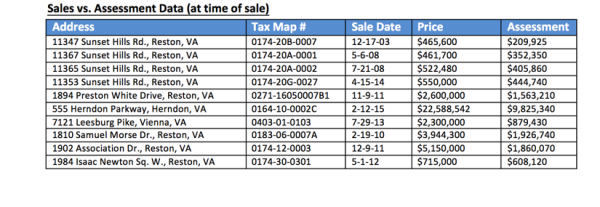 As I’ve mentioned before, I fully support this decision to purchase the Tetra property and urge you, my neighbors, to join me in voting yes.
As I’ve mentioned before, I fully support this decision to purchase the Tetra property and urge you, my neighbors, to join me in voting yes.
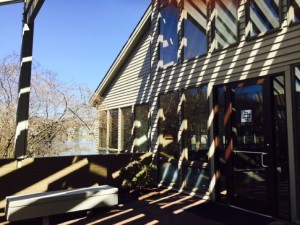 This is an op-ed by Rescue Reston, an open-space advocacy group. It does not represent the opinion of Reston Now.
This is an op-ed by Rescue Reston, an open-space advocacy group. It does not represent the opinion of Reston Now.
Rescue Reston has a focused mission statement of opposing redevelopment of Reston National Golf Course into residential housing or any site development other than a golf course or comparable open space.
Our board sees important parallels between defending the golf course property and the opportunity to purchase the 3.47-acre Tetra property (formerly the Reston Visitors Center). At stake is our control of open space and development in Reston. Rescue Reston therefore recommends that Restonians vote yes in the Tetra Referendum, which is open for voting until 5 p.m. on Friday, May 8.
All seven Rescue Reston board members are Reston Association members. Our own households have voted yes on the referendum. This is a rare opportunity to put this property under the ownership of our homeowner’s association, to serve our interests, and remove the potential for an unknown developer entity to commercially develop the site.
Few developers have ever seen “open space” that couldn’t be improved by a few buildings on it. They have high-powered attorneys who know how to blow their way through almost any “protection” we may think a space is subject to.
As the economic impact of Metro’s Silver Line continues down the line to two other Metro stops in Reston, it is vital that we speak in one voice on issues that affect the open spaces in our neighborhoods. After five Reston Master Plan Phase II community meetings and community outreach, the County and Restonians agreed that the neighborhoods should essentially stay “as built.”
Now, with the draft plan ready to move forward in June to the Board of Supervisors (BOS) for approval, we read that some in the development community are implying there should be more wiggle room for higher density development in our neighborhoods, unchecked by BOS approval or Reston community input: Not enough potential planning for areas outside of transit centers
Both Brian Winterhalter, a lawyer with Cooley LLC, which represents several developers, and Patty Nicoson, Reston resident and Master Plan Phase 1 Task Force Chair, said there is not enough leeway for future development without more comprehensive plan changes.
“It would require comprehensive plan amendments for any redevelopment proposals,” said Winterhalter. “Fundamentally, I don’t think that is the right approach. A community as large as Reston should provide opportunities to grow. This downplanning does not make sense.” Read More
 This is an op-ed by Reston resident Ed Abbott. The opinions expressed here do not represent the views of Reston Now.
This is an op-ed by Reston resident Ed Abbott. The opinions expressed here do not represent the views of Reston Now.
I am a lay member of the Design Review Board (DRB). I have been a member for about five and a half years. My views presented here are my own. My term was up last month and I am not seeking another term.
Much has been written for and against the Reston Association (RA) decision to purchase the Tetra property. Terry Maynard has provided the most comprehensive and compelling analysis of that decision.
Essentially, the RA Board desires to purchase the property to save open space and prevent commercial development of a building, which would allegedly be a restaurant. The question is whether or not it is worth paying $2.65 million for a property that is valued at best at $1.4 million to prevent its commercial use. In my judgment, it is not.
I think one reason is that the Design Review Board is very unlikely to approve of the property’s commercial use, especially as a restaurant. Such development would significantly change the residential nature and aesthetics of the neighborhood.
During my time as a DRB member, I have seen numerous applications which would have had an impact similar to the potential commercial development of Tetra property that have been disapproved or required to undertake significant rework.
For example, the DRB disapproved the construction of several cell towers and required significant changes to the development that would replace the current Fairways Apartments. The latter apparently were significant enough for the developer to postpone construction indefinitely.
The DRB is tasked with assuring all applications are consistent with Reston’s Design Guidelines. This often requires the Board to apply the intent of the guidelines to the specifics of the application. As part of that process, the DRB takes input from the public. In fact, it is required to do so if a neighbor protests. The DRB heard from such “affected parties” in both the cell tower application and the Fairways project.
Regardless of the proposed use of Tetra property, many of the people in Lake Newport would likely register their objections as affected parties, including to any use that RA is contemplating. The DRB takes the affected party comments seriously. In fact, it relies on community input. Based on what I have read in Reston Now, the affected parties on any proposed use of the Tetra property would be numerous and vocal.
For any future owner of the property, including RA, threading Reston’s design guideline needle in the application process would be extremely difficult, if not impossible, given the property’s location.
It makes no sense to spend $2.65 million to prevent development that is very unlikely to happen. At best, the RA purchase of the Tetra property may prevent a very unlikely unwanted development from occurring, but at an exorbitant cost. At worst, RA may be stuck with an overpriced useless building.
The only sensible outcome is to let the current owner deal with this “white elephant” and not make it RA’s.
This is an op-ed by Reston resident and attorney John Farrell. It does not represent the opinion of Reston Now.
The Resource Protection Area is the law when it comes to the Tetra property Reston Association is seeking to purchase.
The Resource Protection Area (RPA) will prevent any lakefront restaurant on the Tetra Property — and Reston Association has known that since at least 2010. Below is an exhibit from the 2010 Appraisal ordered and paid for by Milton Matthews showing both the RPA and the floodplain easement on the Tetra property.
The Chesapeake Bay Preservation Act is part of the Virginia Code: §64.1 44.15:67 et seq. It required Fairfax County to adopt the Chesapeake Bay Preservation Ordinance: Chapter 118 of the County Code.
Section 118-1-7(b)(3)(a) of the County Code requires any water body with perennial flow to be in the RPA. Lake Newport has perennial flow. A 100 foot buffer around Lake Newport is also require to be part of the RPA pursuant to §118-1-7(b)(ii) of the County Code.
While there are a very limited number of exceptions to the RPA in Chapter 118, Article 5, a restaurant is not included among them. Any exception requires a public hearing ( §118-6-3) and any decision on any exception could be appealed to the Board of Supervisors. ( §118-8-1)
A copy of the proffers applicable to the Tetra property can be found on the RA website. The proffers are only two pages. None of those proffers require work in the RPA. Thus, the exception cited in Mr. Sanio’s Op Ed on Monday does not apply.
The 1981 site plan that showed a lakefront restaurant was revised by the prior owner on Oct. 8, 1982 to remove that restaurant as described in Michele Brickner’s 2003 letter that is cited in 2010 Appraisal on page 12. Ms. Brickner was the head of Land Development Services for Fairfax County at the time of her letter.
Thus, while the approved PRC development plan for the Tetra property allows a restaurant somewhere, the RPA prevents it from being located within 100 feet of Lake Newport.
The parking easement held by RA covers almost of the rest of the Tetra property and precludes a restaurant from being built there either.
None of the rulings by the County applicable to Tetra over the last 15 years were appeal by the current or former owner within the appeal period and thus are now “a thing decided and not subject to further review.”
Obviously, the 2010 RA Board did not believe the Appraisal that Milton Mathews’ ordered and the other information that has finally been shared with the membership justified going to referendum to purchase the Tetra. What’s changed since 2010?
Nothing.
 This is an op-ed from Reston Association At-Large Director Michael Sanio. It does not reflect the views of Reston Now.
This is an op-ed from Reston Association At-Large Director Michael Sanio. It does not reflect the views of Reston Now.
I voted yes in the Tetra referendum for the following three reasons:
1) The 3.5 acres Tetra Property next to Lake Newport and the former Reston Visitors Center provides a wonderful space for children’s activities, summer camps, even family weddings and gatherings. Tetra will complement Brown’s Chapel, the Pony Barn and other Reston amenities.
2) In later years, cost for the property are estimated to increase member assessments no more than $5 per year.
3) Reston’s ownership of the Tetra Property will add to open space. Open space that is constantly under pressure from development, especially given the approved development at Lake Anne.
One of the comments I often hear when I speak to friends and neighbors is – the Tetra Property is already protected and can not be developed further. A restaurant can not be built on the site. The existing Fairfax County Resource Protection Act – RPA will prevent further development.
In fact, the existing regulations, and decisions of Fairfax County will allow further, development including a restaurant that can expand over the lake.
This can get technical and legal, so lets get started. Here are the facts:
First, the county RPA maps are guides only. The actual areas included within an RPA are subject to field verification and study by qualified professionals.
Second, there are certain exceptions (where the RPA restrictions do not apply), exemptions (where the regulations themselves provide the ability for certain development activities), limited exceptions for certain zoned development, and waivers (where it is unfair and unproductive to enforce RPA restrictions). The task of analyzing a particular property’s situation is both complicated and fact-specific. Read More
 Tetra Partners has reached an agreement with Reston Association to perform $275,000 in repairs to the building on Lake Newport that RA seeks to purchase.
Tetra Partners has reached an agreement with Reston Association to perform $275,000 in repairs to the building on Lake Newport that RA seeks to purchase.
The two sides reached an agreement on Friday. The money will be held in escrow until Tetra repairs or replaces the HVAC system, roof, windows, paving and other items, according to the contract addendum. The items in disrepair were found during an inspection last month.
RA put in a conditional contract to purchase the 3,128-square-foot building for $2.65 million in late March. The purchase cannot go forward unless a quorum of RA homeowners approves it via referendum. The referendum runs through May 8.
RA said on Friday that the asking price remains $2.65 million. It also estimates it will cost an additional $260,000 to rehab the interior of the building. RA will get a $650,000 developer contribution from Comstock and will also get money from Tetra renting back the building from RA into 2016.
RA wants to repurpose the building — which formerly served as Reston’s Visitors Center and currently serves as Tetra offices — and its 3.48 acres for community space and a lakefront park. It also hopes to stave off commercial development and bring in income in event rentals and child care programs.
The property off of Baron Cameron Avenue sits in between Lake Newport Tennis and Brown’s Chapel Park and would give RA 98 acres of contiguous space.
Opponents of the purchase say the price for the property is too high as its most recent Fairfax County tax assessment was $1.2 million.
RA held a town hall meeting this week to address member concerns about the purchase.
 This is an op-ed from Reston Dave Williams. It does not reflect the views of Reston Now.
This is an op-ed from Reston Dave Williams. It does not reflect the views of Reston Now.
What is the cost of RA NOT buying the Tetra property?
It seems that most Restonians are in favor of RA buying the Tetra property, but are concerned that the price may be too high.
Viewing this purchase in the context of a commercial purchase is, in my view, the wrong perspective.
Rather, the purchase should be viewed from the perspective of value in the context of residential Reston. This is a unique, perhaps one-time, opportunity to purchase wonderful waterfront property located between Reston-owned spaces and in the heart of a number of residential communities.
If RA does not purchase this property, one can be certain that at some point it will be developed commercially to its maximum commercial value — perhaps repeatedly over the years. Commercial development in the heart of a residential area will have a tremendously negative impact on the value and quality of residential Reston.
Viewing this purchase from a commercial investment point of view, I believe, misses the point. Part of the point of the purchase is in fact to prevent commercial development. Of course the owner wants to sell for its maximum commercial potential value. RA wants to use the property but also to prevent such commercial development. However, to expect to be able to purchase the property at a non-commercial value is unrealistic. And it makes it difficult to negotiate with the owner when the purchaser’s bottom line is (rightfully so in this case) publicly available.
We moved to Reston over 20 years ago. We did not move here for its commercial value. We moved here because of its residential value. We moved here because of the woods, the open spaces, the trails, the wildlife and the beautiful peaceful lakes.
For us, RA is primarily in the business of assuring excellent residential quality. If the primary purpose of RA was commercial development, then we should cut down all the trees and fill the open spaces with high rises and commercial development.
Failure to purchase this property would be a huge mistake. If RA cannot purchase the property and has no control over its development and use, years from now, as this property is developed Restonians will look back with regret and say “I can’t believe we let this opportunity slip away.”
Please vote YES to purchase the Tetra property!
Something on your mind? Send a letter to [email protected]. Reston Now reserves the right to edit letters for spelling, style and clarity.
 This is an op-ed by Reston resident John Farrell. It does not necessarily reflect the views of Reston Now.
This is an op-ed by Reston resident John Farrell. It does not necessarily reflect the views of Reston Now.
My very dear friend, Reston Association Board of Directors President Ellen Graves, lent her name to an Op-Ed that appeared on Reston Now last Friday. The editorial was in favor of RA’s $2.6 million purchase of the former Reston Visitors Center.
Early on, Ellen protests that RA did not secretly initiate the negotiations with property owner Tetra. That no one has made this accusation makes the denial gratuitous.
Our source of consternation is the CEO’s admission, reported on Reston Now on April 10, that RA “leadership” secretly worked on this acquisition beginning in the Fall 2014 and only disclosed it to the membership and full Board in late January 2015. That’s when the issue first appeared on the Board’s agenda as an authorization for referendum.
Nothing about that course of events is consistent with the “Reston way” about which Graves waxed poetic last Friday. Neither is it part of the “Reston way” to withhold essential information from the membership or the full Board such as the Feb. 4, 2015 appraisal, which wasn’t released to the full Board until the night of its final vote on the referendum or to the full membership until days later.
How RA Board members were expected to examine, understand, question and evaluate a 95-page appraisal and vote for a $2.6 million referendum the same night is for someone else to explain.
When I heard that my dear friend would be authoring an Op-Ed about the appraisal, I strongly urged her to make sure she read the appraisal before she allowed her name to be put to any article. Sadly, that apparently didn’t happen.
I conclude this because the April 17 Op-Ed made reference to several documents that are not contained in the appraisal. The two zoning administrators interpretations referenced in the Op-Ed are neither referenced in the appraisal, attached to the appraisal or posted on the RA website. This, despite the fact that I personally asked RA land use attorney John McBride for copies of them in early March.
Since the Chesapeake Bay Ordinance that impedes development of the Tetra site is not part of the zoning ordinance, it’s no surprise if there is no mention of it in either of the zoning administrator’s letters.
Similarly, the Op-Ed references the Fairfax County-approved site plan for the restaurant, but it too is not found in the appraisal. There is a drawing of the “as built” for the visitors center that isn’t county approved and has the restaurant struck through; probably because the restaurant wasn’t going to be built before the county bonds for the public improvement for the visitors center were released in the mid-1980s. Read More
It was standing-room only at Brown’s Chapel on Tuesday night as Reston Association members attended a mostly civil town hall meeting to discuss RA’s plans to purchase the former visitors center property from Tetra Partners for up to $2.65 million.
Members are in the midst of a referendum that will either move the process forward — RA would like to close the deal by late July — or kill it.
The general consensus of those at the meeting seemed to support the idea that purchasing the 3.48-acre property to fend off development, preserve green space and add an RA amenity was a good one — but the price is too high.
The 2015 Fairfax County tax assessment values the property — which features a 3,128-square-foot contemporary building that needs both structural repair and interior renovation — at $1.2 million. RA’s 2015 appraisal says the building, when considered for its highest and best developed use — is worth $2.7 million.
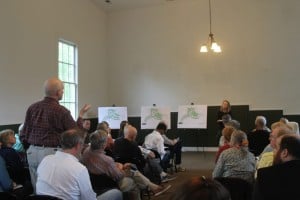 “I am in favor of RA purchasing, but not necessarily in favor of the price,” said Stuart Patz, a member who is in the commercial real estate business. “It doesn’t make sense to me. My take is you are trying to find a use for the property, and you are coming up with a use that doesn’t make sense.
“I am in favor of RA purchasing, but not necessarily in favor of the price,” said Stuart Patz, a member who is in the commercial real estate business. “It doesn’t make sense to me. My take is you are trying to find a use for the property, and you are coming up with a use that doesn’t make sense.
“I applaud you for working on this, but I hope you can negotiate the price.”
RA estimates it will generate $122,000 annually from event rentals, meeting space and after-school and after-camp child care programs. Several in the crowd said they were skeptical that RA would generate that income. Read More
This is an op-ed by former Reston Citizens Association president Colin Mills. It does not represent the views of Reston Now.
What makes Reston a special place? To a lot of us — including me — it’s the careful design and planning that went into its creation.
 One important element of that planning is the integration of open space and natural areas throughout Reston. As Bob Simon said in one of his founding principles, “Beauty — structural and natural — is a necessity of the good life and should be fostered.”
One important element of that planning is the integration of open space and natural areas throughout Reston. As Bob Simon said in one of his founding principles, “Beauty — structural and natural — is a necessity of the good life and should be fostered.”
It’s extremely valuable that even in the middle of a thriving, growing, busy community, there are pockets of green where we can experience tranquility and beauty. Right now, we have the opportunity to help preserve one of those green spaces in Reston. I hope that our citizens will take advantage of it.
I support RA’s plan to purchase the Tetra property for a variety of reasons. As a student of Reston history, I appreciate the idea of preserving the old Visitors Center. As a longtime patron of RA programs, I support adding another venue to host programs and accommodate our growing population.
Neither of those is the key reason to me, though. What matters most to me is what RA would add to the parcel — trees, shrubs, and green space — as well as what it wouldn’t add, which is more development in a location that would add more traffic to our streets and threaten our existing natural resources.
During my three years as president of RCA, we spent a great deal of time advocating for careful planning of Reston’s future growth. We recognized that growth and development is coming, and it’s foolish to think that we can stop the clock and preserve Reston exactly as it is forever. But we urged that development be concentrated in areas that were designed for it, such as in the vicinity of the Silver Line stations and the existing village centers.
We strongly opposed development in and near existing stable residential neighborhoods, in spots that would threaten our existing green space and environmental resources, and in areas that would worsen our already-clogged traffic. The Tetra property fails on all three counts. Read More
 Want to learn more about what you may be buying?
Want to learn more about what you may be buying?
Then attend tonight’s community meeting, where Reston Association members can get a look around the controversial Tetra Building the association wants to purchase.
Reston Association staff will also answer questions. Members will take a tour of the grounds, but will not be able to enter the building, says RA spokesman Kirsten Carr.
The meeting begins at 6 p.m. at Brown’s Chapel, 1575 Brown’s Chapel Rd., and will include a tour of the Tetra building, which served as Reston’s Visitor Center from 1983 to 2003.
Reston Association has put in a conditional contract to purchase the 3,129-square-foot structure that overlooks Lake Newport. Acquiring the building at 11450 Baron Cameron Ave. (as well as its its 3.48 acres of land) would also give RA 98 contiguous acres of community space as the plot abuts other RA properties such as Brown’s Chapel Park and Lake Newport. RA says purchasing the building — for up to $2.65 million — will fend off development and add a recreational and community amenity to RA’s holdings.
The building is currently designated as commercial space and was formerly approved for nearly 7,000 more feet of space to be added. Meanwhile, Tetra has said several large restaurant companies have looked at the space, but no deal was currently in place.
Opponents of the purchase have pointed out that the asking price is more than double the latest Fairfax County tax assessment and commercial development is unlikely to ever happen at the spot because it is in a flood zone and there are many easements crossing the property. RA says it will answer questions on Tetra at Tuesday’s meetings.
At a series of district meetings in March, RA staff and board members made presentations but did not answer questions on the purchase. A look at building — which will undergo major renovations that RA estimates will cost at least $250,000 — will also give the community the chance to envision it as something other than its current office space use. RA says it would like to use it for meeting and event rentals, after school programs and classes, among others.
The purchase cannot happen without a member referendum, which began April 13 and will run through May 8. There will be a chance to vote in the referendum at Tuesday’s meeting. Voting is also available by mail or online.
See additional details on the purchase, including a fact sheet, building inspection report and appraisal on RA’s website.
This is an op-ed by Reston resident Terry Maynard. It does not necessarily reflect the opinion of Reston Now.
Contrary to RA President Ellen Graves’ op-ed on Friday, the planned RA purchase of the Tetra property is neither a good value now nor a good investment in the long term. Only Reston voters now can stop this ill-conceived, secretly planned purchase by voting “NO” in the ongoing RA referendum.
The price RA has committed to paying, subject to the referendum vote, is $2.65 million. The $2.65 million price is two and one-half its current market value of the Tetra property as measured by both Fairfax County in its annual real estate assessment and the RA-funded appraisal and property condition report.
The County puts the value of the Tetra property at $1.20 million as of Jan. 1, 2015. That is down about $44,000 from last year. And, as you probably know, the County is obligated under state law to assess real estate at its fair market value.
The property appraisal prepared for RA by The Robert Paul Jones Company, LLC, (RPJ) walks through the property’s “as is” valuation in two ways: comparable sales and income approach. After putting the comparable sales valuation at $1.45 million and the income approach valuation at $1.1 million, it arrives at an “as is” fair market value of $1.3 million. (See p. 22 of the RPJ appraisal.) Read More


